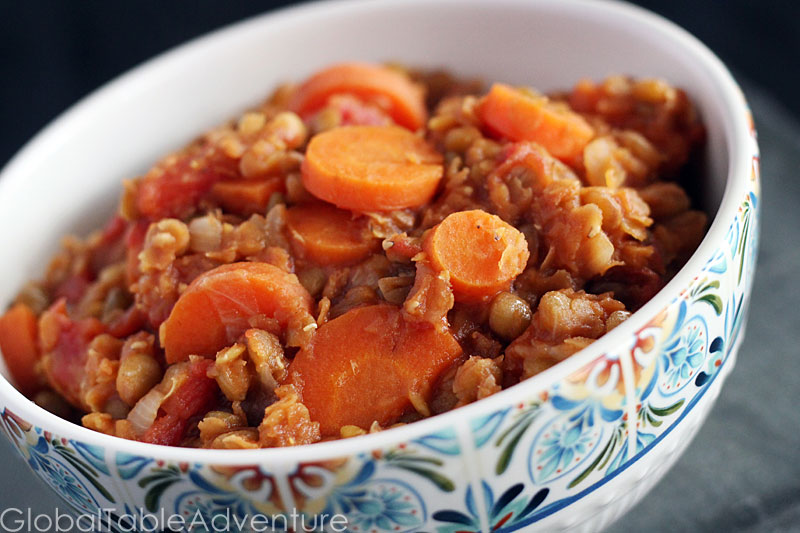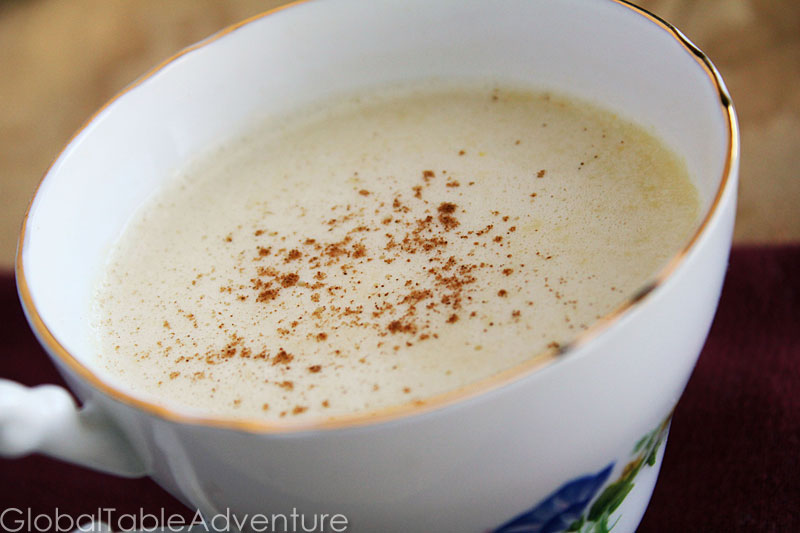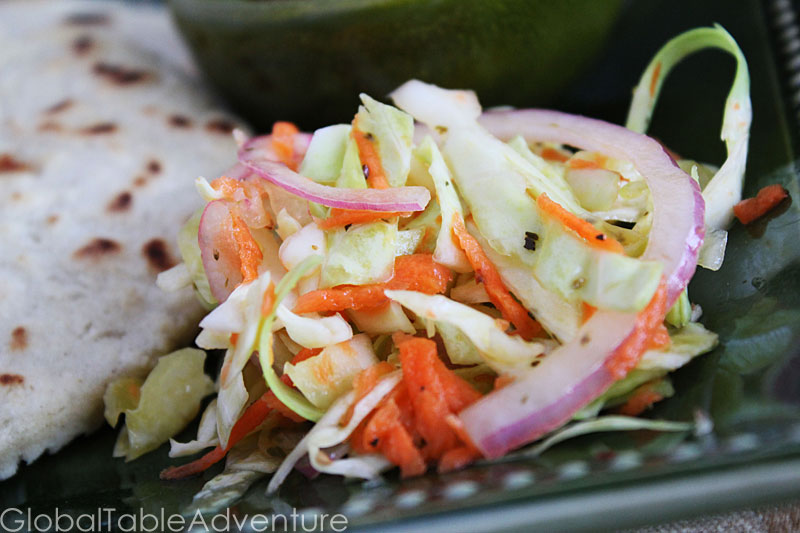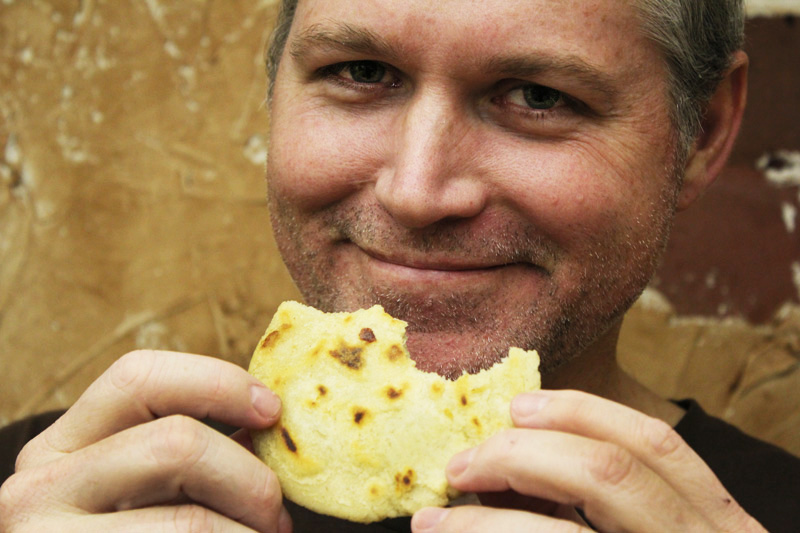Serves 2-4 I was a total lamb newb before starting Global Table Adventure – I simply had never cooked it. Sure, I grew up eating it with mint jelly (although the jelly always stayed on my plate, untouched), but the actual process of making a tasty meal out of lamb was a mystery to me. Thanks to our Adventure, it’s becoming rather second nature and this Ethiopian recipe might be my favorite lamb recipe thus far (barely edging out the Roast Lamb from Cyprus). Our recipe is adapted from Laura Kelley of Silk Road Gourmet, a most wonderful author and world traveler. Serve with Injera. Ingredients: 1/8 cup peanut oil 2 red onions, chopped 1 inch fresh ginger, peeled and grated (about 1 1/2 tsp) 3 cloves garlic, crushed 2 tsp berberé 1 cup beef stock 1.2 lbs cubed lamb yogurt, to taste Method: Chop the onions (you can do a large dice or strips) and cook them until golden (10-15 min) over medium high, or until you can no longer stand how good the …
Read More

Coffee is said to have originated in Ethiopia. Today Ethiopian coffee ceremonies are common after large meals, even at restaurants. Women will roast beans in front of the guests. Then she’ll grind the beans, perfuming the room, and brew them in a clay coffee pot, or jebena. The coffee is served in small cups called si’ni. Diners have their choice of salt or sugar. Traditionally, every guest is offered 3 cupfuls- the same grounds being brewed each time, making each consecutive cup weaker. My Rendition At best, I was ill-prepared to perform an Ethiopian coffee ceremony. #1, I live in Tulsa, Oklahoma. #2, I lack every single piece of traditional Ethiopian coffee-making equipment there could possibly be. In fact, the only proper element I have is a bag of green coffee beans. Tilda’s parents brought them all the way over from Ethiopia, known as the birthplace of coffee. At least the coffee was right. I got to work, putting my college nickname “MacGyver” to good use. What follows are the results of a free-spirited, improvisational coffee …
Read More
Serves 8 Is it a tart? a cake? a cheese cake? All of the above? Whatever you call it, this gingerbread love-fest is the perfect combination for a winter dessert buffet. Special thanks to Nami Nami who’s ricotta cheesecake recipe inspired our version. Nami is an Estonian blogger with a great collection of recipes, both from her home country and beyond. Cheers! Ingredients: 15 oz container whole milk ricotta 1/4 cup sugar 1/2 tsp cinnamon 1/4 tsp cardamom 3 large eggs 1/8 cup heavy cream 1/2 gingerbread dough (there will be scraps leftover to make decorative cookies to put on the top of the cake) Garnish: Lingonberry jam, to taste Method: Take a few minutes to build a snowman. If there are no snowmen to be made, sit outside and drink a cup of tea and think about building a snowman. Ok, now you’re ready to bake this Estonian treat. First, place a water bath in the oven (a large pan half full of hot water) and preheat it to 350F. Meanwhile, in a medium bowl, …
Read More
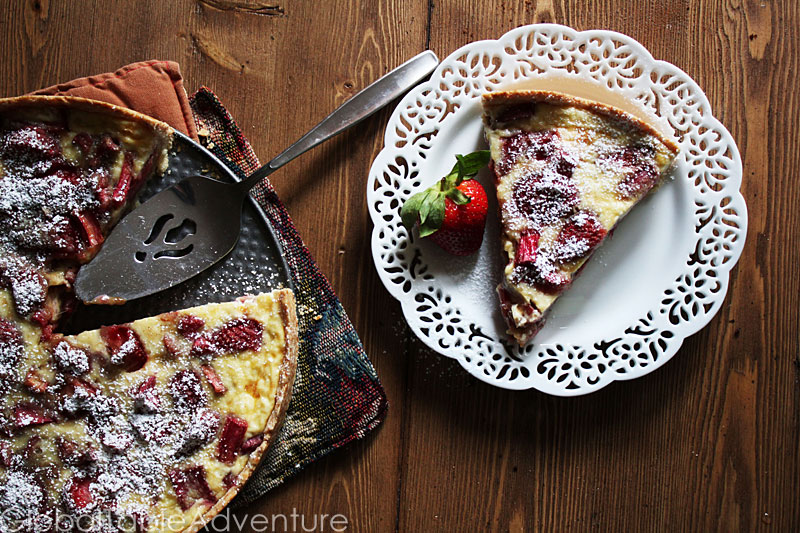
Want a bite of Estonian springtime? Go for rhubarb, the most beloved, cold-climate vegetable around. It looks like celery with lipstick, but tastes fruity and tart. Elizabeth Schneider explains the special place rhubarb has in countries like Estonia: Imagine that you’ve spent the winter eating fruits and vegetables rationed from a root cellar and canning jars. Now imagine the first rosy rhubarb of the year, welcome as new grass. Not so long ago, rhubarb held a special place in the culinary calendar as a unique fresh food, the earliest harbinger of spring. Vegetables from Amaranth to Zucchini 5 Fun facts about Rhubarb: Never eat the leaves, cooked or raw. They are toxic. Never cook rhubarb in aluminum – it will dull the fruit’s color. Look for flat, deep red stalks. They have the most flavor. Rhubarb can be mild or extremely tart. You may need to adjust your sweeteners accordingly. Rhubarb season begins in March, but hothouse rhubarbs are available as early as January. RECIPE Serves 8-10 A casual dusting of confectioner’s sugar gives this …
Read More
Serves 4 Let’s thank Eritrea for this giant, vegan bowl of deliciousness – a happy mixture of spicy lentils, offset by sweet carrots and tomatoes. The heat comes from berberé, the regional spice blend that should be added with a heavy hand. You know, for authenticity purposes. And lots of sweating. Edited to add: One of our readers posted a great tip in the comments section of our Ethiopian menu which also applies to Eritrean cooking: When I watch Ethiopian cooks in Ethiopia they chop up red onion very tiny (I use a food processor and stop short of pulverizing as it helps it cook down faster) and then dry cook it in the pan — no oil. They dry cook it stirring constantly until it turns almost into a paste — imagine the consistency of a good roux. It takes a lot of onion to get the right amount of this paste. Then add the oil/lentils, sauce stuff, etc. The onion paste is actually the thickener for the wat — if you don’t do …
Read More

Serves 2 You’ve seen them at the fish market. Whole trout. Somewhat intimidating, but also intriguing. Friends, if you’ve never ventured in the world of whole fish, I highly recommend it. Cooking them is beyond easy and the flavor is exceptional. Today we stuff them with peppers, onions, and fresh lemons – flavors characteristic of Equatorial Guinea. Slightly spicy and super fresh – make this for a special occasion or just for fun. Ingredients: 2 whole trout, cleaned 1/4 cup thinly sliced poblano 1/4 cup thinly sliced onion 4 lemon slices salt pepper Method: First things first. Light a candle. The flickering light is warm and inviting, and does a great job of eating up fish smells. I burn candles daily, fish or no fish. Gather your ingredients and preheat the grill to medium. You won’t need too much onion and pepper, unless your fish are huge. Rinse and pat dry the fish. Then season the cavity with salt and pepper – preferably fresh, coarse sea salt. Add thinly sliced onions and poblanos… for a little …
Read More
Serves 3 In El Salvador, Atol is made with fresh corn kernels, milk, cinnamon, and sugar. My version is simplified for the home cook – but if you have the time, and if it is in season, cut the corn straight off the cob. Do it while listening to Salvadoran music, just because. Ingredients: 1 lb frozen corn, thawed 2 cups milk 1 cinnamon stick 1/4-1/2 cup sugar extra milk, as needed ground cinnamon for garnish Method: Add golden nuggets of goodness to a medium pot. Balance a cinnamon stick on top. Pour milk over the cinnamon stick… and click on the heat. While the milk is coming to a simmer, pour on the sugar. (If you don’t have a crazy wild sweet tooth, just add 1/4 cup. Also, if your corn is ultra sweet you may not need so much). Give everything a buzz with an immersion blender. Simmer about 15-20 minutes, then strain out all the fibers and yucky bits. Put those in your garden. Reheat the strained mixture if it cools down …
Read More
Makes 1 giant bowl. Vinegar lovers unite! With very little effort you can have this Salvadoran slaw at your next barbecue or gathering. To be authentic, serve slightly “pickled” – about 1-3 days after making it. This should be vinegary and with the slightest hint of heat. Serve with pupusas. Ingredients: 1 cabbage, cored and sliced thinly 1/2 red onion, sliced thinly 2 carrots, grated 1 tsp dried oregano 1/2 tsp red pepper flakes 1/4 cup white wine vinegar 1/8 cup olive oil salt and pepper, to taste (I put in 2/3 tsp salt) Method: Time to get out all your aggression on some red onion, cabbage, and carrot. Chop, chop, chop like there’s no tomorrow. Well really… slice thinly. Chopping is a bit too coarse for this recipe. When you’re done, mix the vinegar with olive oil, red pepper flakes and oregano. Add a little water if desired (maybe 1/8 cup) and season with salt and pepper. Pour over the veggies. Toss and refrigerate for 1-3 days. It gets better and better and … …
Read More

Makes 18-22 cupcakes Don’t expect cheese and tortillas. Instead, think poundcake. Think party food. Think happy mornings, popping a few too many quesadillas in your mouth. In El Salvador they eat rich, buttery quesadillas in the morning with a big cup of coffee and I suggest you do the same. You’ll love the slight crunch of the sesame seeds in combination with the sweet/salty cake. I’m proud to say that this recipe was awarded First Place in food52‘s Gluten-Free Baking Competition. Best served with dulce de leche and a cloud of whipped cream. Ingredients: 1 cup rice flour 1 tsp baking powder 1 pinch salt 1 cup butter 1 cup sugar 3 eggs 1 cup sour cream 1/2 cup grated hard cheese, like cotija (parmesan can be substituted) sesame seeds, to taste Method: Get your baking shoes on! You’re about to whip up a batch of Salvadoran goodness. Gather your ingredients, then preheat the oven to 350F. Whisk together the rice flour, baking powder, and salt. Meanwhile, in a standing mixer, cream the butter with …
Read More
Makes 6-10 pupusa Take a big bite of El Salvador with cheesy pupusas. Many locals eat pupusa several times a week – some are filled with beans, others meat. But, no matter how you fill it, there’s an art to shaping the mighty pupusa. Here’s Martha Stewart’s demonstration: http://www.youtube.com/watch?v=kShxKY1mrPM Here are four things I wish I knew when I got started: Make your dough fairly moist. Play with the consistency. You don’t want a lot of cracking on the edges. The one Keith is holding is perfect. My others (pictured in the recipe) were a little dry and as a result, not so great. Rub vegetable oil on the pupusa before you put it on the griddle. This will keep it from – ahem – drying out. It will also give it a pretty, golden color. The one Keith is holding is nice and golden. The others are pale because I forgot this step. Make the pupusa thinner for a cheesier effect. Use salt. It really pulls the flavors together. By making sure I did …
Read More
Makes 1 cup Want to drink a rose? White Coffee is the fabulous way to be romantic. Just boil a pot of water and 15 seconds later you’ll be sipping on a hot cup of romance, relaxation and restful enjoyment. Although called white coffee, this popular Middle Eastern drink is really a caffeine-free blend of hot water with floral essences, spices, herbs, or aromatics. Our version is made especially for Valentine’s Day with one of the most popular variations, rose water. Psst, it helps to serve this drink with a bundle of pretty, pink roses. Ingredients: 8 oz hot water 1-2 tsp rose water sugar cubes Method: Get out one of your favorite tea cups. It should be delicate, old, and – even when empty – full of memories. This tea set came from two places. I purchased some of them at an antique mall right after college, in Connecticut (oh, about 9 years ago). The rest once belonged to Keith’s grandmother in Oklahoma. She had the same exact set. Is that fate or what? …
Read More






